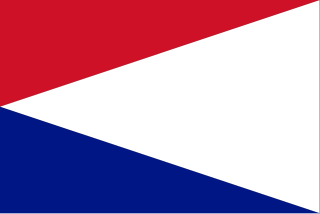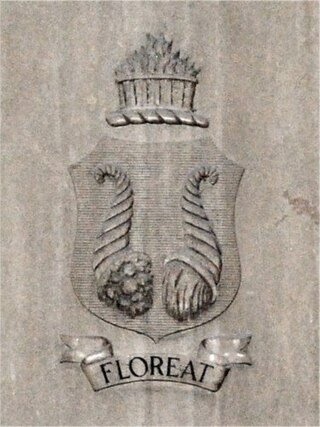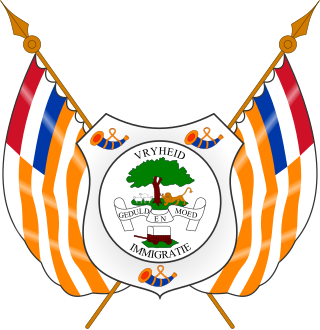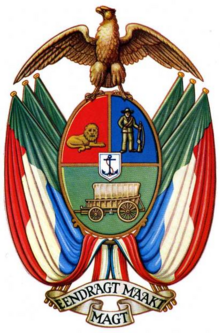
The coat of arms of South Africa is the main heraldic insignia of South Africa. The present coat of arms was introduced on Freedom Day, 27 April 2000, and was designed by Iaan Bekker. It replaced the earlier national arms, which had been in use since 1910. The motto is written in the extinct |Xam, member of the Khoisan languages, and translates literally to "diverse people unite". The previous motto, in Latin, was Ex Unitate Vires, translated as "From unity, strength".

The flag of Cape Colony was the official flag of the Cape Colony from 1876 to 1910. It formed part of a system of colonial flags that was used throughout the British Empire.

The coat of arms of the Cape Colony was the official heraldic symbol of the Cape Colony as a British colony from 1875 to 1910, and as a province of South Africa from 1910 to 1994.

The coat of arms of Namibia is the official heraldic symbol of Namibia. Introduced at the time of independence in 1990, it superseded the earlier coat of arms used by the South African administration of the territory.

The coat of arms of the Western Cape is the official heraldic symbol of the Western Cape province of the Republic of South Africa. It has been in use since 1998.

The flag of the Natalia Republic was the official flag of this short-lived South African state, which existed from 1839 to 1843.

The flag of the Orange Free State was officially used from 1857 to 1902. It was superseded by the flag of the Orange River Colony.

South African heraldry dates back to the 1650s, inheriting European heraldic traditions. Arms are borne by individuals, official bodies, local authorities, military units, and by a wide variety of organisations. South Africa has had its own heraldic authority since 1963, to provide armigers with legal protection, and to promote high standards of armorial practice.

CVO Skool Pretoria is a private Afrikaans, Christian school. The school is located adjacent to Shere Smallholdings, approx. 10 km to the east of Lynnwood, Pretoria, South Africa.

The Flag of Transvaal was the official flag of the Transvaal colony in South Africa from circa 1903 to 1910. It formed part of a system of colonial flags that was used throughout the British Empire. It was superseded by the flag of the Union of South Africa.

Since unification in 1910, South Africa has used a range of national symbols to identify the country: coats of arms, official seals, flags, national anthems, and floral, bird, animal, and other emblems.

The coat of arms of the Orange Free State was the official heraldic symbol of the Orange Free State as a republic from 1857 to 1902, and later, from 1937 to 1994, as a province of South Africa. It is now obsolete.

The coat of arms of Natal was the official heraldic symbol of Natal as a British colony from 1907 to 1910, and as a province of South Africa from 1910 to 1994. It is now obsolete.
The coat of arms of the Orange River Colony was the official heraldic symbol of the Orange River Colony as a British colony from 1904 to 1910, and then of the Orange Free State province of South Africa from 1910 to 1925. It is now obsolete.

The flag of Natal was the official flag of the South African colony of Natal from 1870 to 1910. It formed part of a system of colonial flags that were used throughout the British Empire.

The flag of the Orange River Colony was the official flag of the Orange River Colony in South Africa from 1904 to 1910. It formed part of a system of colonial flags that was used throughout the British Empire. It was superseded by the Flag of the Union of South Africa.

The South African Republic, which existed from 1852 to 1877, 1881 to 1902, and 1914 to 1915, used two flags: (1) the so-called 'Vierkleur' from 1857 to 1874, and again from 1875 to 1877 and 1881 to 1902, and (2) the so-called 'Burgers Flag' from 1874 to 1875. They were superseded by the flag of Transvaal. The Vierkleur was also used by the South African Republic declared in 1914 during the Maritz Rebellion, which lasted into February 1915.
Cornelis Pama was a Dutch bookseller, publisher, heraldist and genealogist, who spent the second half of his life in South Africa.

The first coat of arms of South Africa was granted to the Union of South Africa by King George V and later amended by the British College of Arms. It contained representation of the four provinces within the Union. The coat of arms was later retained by the Republic of South Africa after independence and for a period until after the end of apartheid, until being retired in 2000. The 1910 coat of arms was replaced in 2000 by the current coat of arms of South Africa.


















